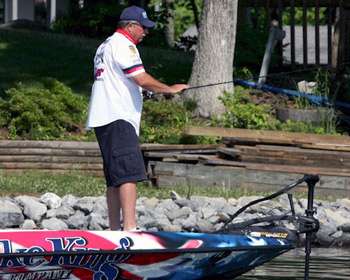
You've found the perfect piece of isolated cover adjacent to a creek channel — a spot where you're certain that there's a giant bass lying in wait for a shad to come downstream. After approaching the tree with your trolling motor on high, you quickly have to reverse the boat in order to avoid making contact with the target you're set on fishing.
Knowing that the bass on your lake are particularly susceptible to a jig, you quickly lob one into the heart of the bushiest portion of the laydown. Without getting a strike, you're convinced there isn't a fish in the area and quickly move on.
Denny Brauer says that scenario and similar ones occur far too often. And no matter how many times he's asked about it, the topic of properly fishing isolated cover still evokes a chuckle from the seasoned Elite Series pro.
"Approaching isolated cover can be frustrating for a lot of people because they tend to mess up a lot more areas than they actually fish right," he points out. The mistake occurs most often in river systems, or anywhere there's current. "If you're fishing with the current instead of against it, you're not fishing at the same speed that Mother Nature is moving," Brauer points out. "You should always be fishing with the nose of your boat heading into the current; that way you can ease into the target and have the current drift your bait past the strike zone."
Many times, anglers will focus on the "fishiest" looking portion of the cover and make an errant cast to that spot. This will, in many cases, spoil the remainder of the target. To solve this, he recommends covering the target by starting at the outside edges and working your way in. "This is very, very important," he stresses. "If you pitch right into the heart of a big tree, you'll more than likely spook anything else that was in there on your first cast. If you approach it correctly, you can catch not just one, but maybe a limit of fish from that one piece of cover."
When current isn't obvious, anglers will often hop from target to target and ignore other factors that could be generating flow in the lake or reservoir they're fishing. "You need to be mindful of what the wind is doing," he recommends. "If you've got wind, it's almost like fishing in current because it's pushing the boat or disrupting the water's surface."
For that reason, when fishing isolated cover, Brauer will not approach it directly. "I like to parallel the shore because I can swing the nose of the boat away from the target as I come closer," he explains. "If you're coming straight at it, you will inevitably end up back washing the spot with your trolling motor because you've got all of your boat's momentum pushing you toward the target.
You do not want to be flushing water under the cover you're trying to fish until after you're finished." Backwash, he points out, can actually be an ally in some situations, provided you've already fished the area thoroughly. "A lot of times it's not a bad idea to flush the cover you're fishing out with your trolling motor," he explains. "If you've fished it and haven't gotten a bite, by flushing some water under it you might actually reposition the fish. In a few minutes you're liable to come right back there and catch one or two."
Denny emphasizes that stealth is the key to being able to identify and further develop patterns when fishing isolated cover. "When you're approaching isolated cover, you want to be very stealthy," he says. "I really like to work my way around the cover until I figure out where they're holding. "Once I'm able to do that, it becomes very easy, and I can go from place to place and pinpoint where the bass are."
(Provided by Z3 Media)




